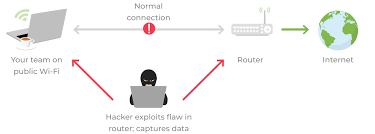Unsecure Wi-Fi networks and phishing hotspots pose significant risks to your online security and privacy. Here are some warning signs to be aware of and precautions to take when encountering such networks:
- Lack of Password Protection: Unsecure Wi-Fi networks often lack password protection, allowing anyone within range to connect without authentication. Be cautious when connecting to open networks that do not require a password, as they can be easily exploited by attackers.
- Generic or Misleading Network Names: Attackers may create Wi-Fi networks with generic or misleading names to trick users into connecting to them. They may use names like “Free Public Wi-Fi” or mimic the name of a legitimate establishment. Always verify the network name with the authorized provider or establishment before connecting.
- Unusual or Unexpected Network Popularity: If you notice a network with an unusually high number of available connections, it could be a sign of a phishing hotspot. Attackers may set up these networks to attract unsuspecting users and steal their sensitive information.
- Missing Encryption or Weak Security: Secure Wi-Fi networks should use encryption protocols like WPA2 or WPA3 to protect data transmitted over the network. If you encounter a network that does not use encryption or has weak security measures, it is best to avoid connecting to it, as your data could be intercepted by attackers.
- Certificate Warnings: When connecting to a Wi-Fi network, your device may display a certificate warning if the network’s security certificate is invalid or self-signed. Treat such warnings as red flags and avoid connecting to the network, as it may indicate an unsecure or malicious hotspot.
- Unexpected Captive Portals: Some unsecure networks may employ captive portals that require users to provide personal information or login credentials before accessing the internet. Exercise caution when encountering such portals, as they can be used to collect sensitive data for malicious purposes.
To protect yourself from unsecure Wi-Fi networks and phishing hotspots:
- Use Trusted Networks: Whenever possible, connect to secure and trusted Wi-Fi networks, such as those provided by reputable establishments, your workplace, or your home network.
- Enable Firewall and VPN: Activate the firewall on your device to add an extra layer of protection against unauthorized access. Additionally, consider using a reputable virtual private network (VPN) service to encrypt your internet connection and protect your data when using public Wi-Fi.
- Verify Network Details: Before connecting to a public Wi-Fi network, confirm the network name and password with the authorized provider or establishment. Avoid connecting to networks with generic names or those that you don’t recognize.
- Avoid Transmitting Sensitive Information: When connected to unsecure Wi-Fi networks, refrain from transmitting sensitive information such as passwords, financial details, or personal data. Wait until you have a secure and trusted connection before engaging in such activities.
- Be Cautious of Phishing Attempts: Phishing attacks can occur on any network, including unsecure Wi-Fi networks. Be vigilant and avoid clicking on suspicious links or providing personal information in response to unexpected requests.
- Use Cellular Data or Personal Hotspots: If you are unsure about the security of a Wi-Fi network, consider using your cellular data or setting up a personal hotspot on your mobile device instead. This way, you can have a more secure and controlled internet connection.
By staying cautious, using secure networks whenever possible, and taking necessary precautions, you can reduce the risk of falling victim to unsecure Wi-Fi networks and phishing hotspots.
SHARE
